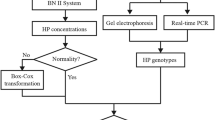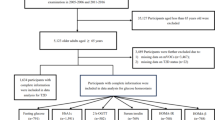Abstract
Background/Aim
The genetic polymorphism of haptoglobin (Hp) has been associated with several cardiovascular risk factors, but a possible relationship between Hp phenotypic variation and increased levels of homocysteine (Hcy) and cysteine (Cy) is still unknown. The objective of this study is to evaluate the relationship between the Hp polymorphism and hyperhomocysteinemia (HHcy) and hypercysteinemia (HCy) in type 2 diabetics (T2D) with and without angiopathy (AGP).
Methods
A case-control study was carried out on 293 adults: Group I (GI) - 75 subjects with T2D and AGP; Group II (GII) - 75 subjects with T2D without AGP; Group III (GIII) - 143 controls. Plasma levels of Hcy, Cy and vitamin B6 were measured by high performance liquid chromatography (HPLC) and vitamins B9 and B12 determined by electrochemiluminescence (ECL). The Hp polymorphism was identified by sodium dodecyl sulfate–polyacrylamide gel electrophoresis (SDS-PAGE) and peroxidase staining. The results were analyzed in SPSS®, version 26.0 with a significance of 95%.
Results
Mean Hcy concentrations were significantly lower in carriers of the Hp2-2 phenotype (6.14 µM; p = 0.046) compared to the other genotypes. The presence of Hp2-1 is associated with an approximately 3.3 times greater probability of occurrence of HHcy (p = 0.015) and 3.7 times greater probability occurrence of HCy (p = 0.021) in T2D with AGP.
Conclusion
The presence of the Hp2-1 phenotype is associated with the predisposition of HHcy and HCy in individuals with T2D and AGP, possibly through a positive heterosis mechanism. Carriers of the Hp2-2 phenotype appear to have a greater activation of the transsulfuration pathway in the Hcy cycle and consequent protection for its accumulation.
This is a preview of subscription content, access via your institution
Access options
Subscribe to this journal
Receive 12 print issues and online access
$259.00 per year
only $21.58 per issue
Buy this article
- Purchase on SpringerLink
- Instant access to full article PDF
Prices may be subject to local taxes which are calculated during checkout
Similar content being viewed by others
Data availability
All data generated or analyzed during this study are included in this published article.
References
Levy AP, Levy JE, Kalet-Litman S, Miller-Lotan R, Levy NS, Asaf R, et al. Haptoglobin genotype is a determinant of iron, lipid peroxidation, and macrophage accumulation in the atherosclerotic plaque. Arterioscler Thromb Vasc Biol. 2007;27:134–40.
Kalmovarin N, Friedrichs WE, O’brien HV, Linehan LA, Bowman BH, Yang F. Extrahepatic expression of plasma protein genes during inflammation. Inflammation. 1991;15:369–79.
Langlois MR, Delanghe JR. Biological and clinical significance of haptoglobin polymorphism in humans. Clin Chem. 1996;42:1589–600.
Sadrzadeh SMH, Graf E, Panter SS, Hallaway PE, Eaton JW. Hemoglobin. A biologic fenton reagent. J Biol Chem. 1984;259:14354–6.
Wobeto VPA, Zaccariotto TR, Sonati MF. Polymorphism of human haptoglobin and its clinical importance. Genet. Mol Biol. 2008;31:602–20.
Farbstein D, Soloveichik YZ, Levy NS, Levy AP. Genetics of Redox Systems and Their Relationship with Cardiovascular Disease. Curr Atheroscler Rep. 2011;13:215–24.
Esse R, Barroso M, de Almeida IT, Castro R. The Contribution of Homocysteine Metabolism Disruption to Endothelial Dysfunction: State-of-the-Art. Int J Mol. Sci. 2019;20:867.
Koklesova L, Mazurakova A, Samec M, Biringer K, Samuel SM, Büsselberg D, et al. Homocysteine metabolism as the target for predictive medical approach, disease prevention, prognosis, and treatments tailored to the person. EPMA J. 2021;12:477–505.
Quaye IK, Ababio G, Amoah AG. Haptoglobin 2-2 phenotype is a risk factor for type 2 diabetes in Ghana. J Atheroscler Thromb. 2006;13:90–4.
Melamed-Frank M, Lache O, Enav BI, Szafranek T, Levy NS, Ricklis RM, et al. Structure-function analysis of the antioxidant properties of haptoglobin. Blood. 2001;98:3693–8.
Delanghe JR, Delrue C, Speeckaert R, Speeckaert MM. Unlocking the link between haptoglobin polymorphism and noninfectious human diseases: insights and implications. Crit Rev Clin Lab Sci. 2023;27:1–23.
Naryzny SN, Legina OK. Haptoglobin as a Biomarker. Biochem Mosc Suppl B Biomed Chem. 2021;15:184–98.
Carter K, Worwood M. Haptoglobin: a review of the major allele frequencies worldwide and their association with diseases. Int J Lab Hematol. 2007;29:92–110.
Farbstein D, Levy AP. The genetics of vascular complications in diabetes mellitus. Cardiol Clin. 2010;28:477–96.
Bale BF, Doneen AL, Vigerust DJ. Precision Healthcare of Type 2 Diabetic Patients Through Implementation of Haptoglobin Genotyping. Front Cardiovasc Med. 2018;16:141.
Roguin A, Koch W, Kastrati A, Aronson D, Schomig A, Levy AP. Haptoglobin genotype is predictive of major adverse cardiac events in the 1-year period after percutaneous transluminal coronary angioplasty in individuals with diabetes. Diabetes Care. 2003;26:2628–31.
Lioupis C, Barbatis C, Drougou A, Koliaraki V, Mamalaki A, Klonaris C, et al. Association of haptoglobin genotype and common cardiovascular risk factors with the amount of iron in atherosclerotic carotid plaques. Atherosclerosis. 2011;216:131–8.
Kulcsar J, Cogoi B, Karanyi Z, Szabo K, Kovacs K, Olah L, et al. Haptoglobin (2-2) Polymorphism together with elevated homocystein level enhance the risk for subclinical atherosclerosis in type 2 diabetic men. Atherosclerosis. 2015;241:E179–80.
World Medical Association. World Medical Association Declaration of Helsinki: ethical principles for medical research involving human subjects. JAMA. 2013;310:2191–4.
International Physical Activity Questionnaire (IPAQ). 2004. https://drive.google.com/file/d/1WKqWQLjwhaD3uRpPQ9u558wlC22dkrWq/view.
Valente A, Bronze MR, Bicho M, Duarte R, Costa HS. Validation and clinical application of an UHPLC method for simultaneous analysis of total homocysteine and cysteine in human plasma. J Sep Sci. 2012;35:3427–33.
Valente A, Bicho M, Duarte R, Raposo JF, Costa HS. Vitamin B6 status in Portuguese type 2 diabetic patients with and without retinopathy. Public Health Nutr. 2010;13:232.
Linke RP. Typing and subtyping of haptoglobin from native serum using disc gel electrophoresis in alkaline buffer: application to routine screening. Analyt Biochem. 1984;141:55–61.
Bicho MC, Silva AP, Natos A, Silva RM, Bicho MD. Sex steroid hormones influence the risk for cervical cancer: modulation by haptoglobin genetic polymorphism. Cancer Genet Cytogenet. 2009;191:85–9.
Valente A, Marques-Vidal P, Costa HS. An improved and validated high-performance liquid chromatography method for measuring malondialdehyde levels in human serum. Ann Nutr Metabol. 2007;51:284.
Shi X, Sun L, Wang L, Jin F, Sun J, Zhu X, et al. Haptoglobin 2-2 genotype is associated with increased risk of type 2 diabetes mellitus in northern Chinese. Genet Test Mol Biomarkers. 2012;16:563–8.
Mishra S, Siddiqi S, Kashyap A. Nkagrawal. Polymorphism Of Human Haptoglobin and Its Importance In Diabetic Nephropathy. Dig J Nanomater Biostruct. 2010;5:599–603.
Dalan R, Liew H, Goh LL, Gao X, Chew DE, Boehm BO, et al. The haptoglobin 2-2 genotype is associated with inflammation and carotid artery intima-media thickness. Diab Vasc Dis Res. 2016;13:373–6.
Filipek A. Hp1-1 as a Genetic Marker in Diabetes: Measures, Applications, and Correlations. In: Patel, VB, Preedy, VR, editors. Biomarkers in Diabetes. Biomarkers in Disease: Methods, Discoveries and Applications. Cham: Springer; 2022. pp 1–22.
Mokgalaboni K, Mashaba GR, Phoswa WN, Lebelo SL. Folic acid supplementation on inflammation and homocysteine in type 2 diabetes mellitus: systematic review and meta-analysis of randomized controlled trials. Nutr Diabetes. 2024;14:22.
Al Fatly M, Mulder MT, van Lennep JR, Blom HJ, Berk KAC. The effect of diet-induced weight loss on circulating homocysteine levels in people with obesity and type 2 diabetes. Nutr J. 2024;23:2.
Xu T, Chen S, Yang F, Wang Y, Zhang K, Fu G, et al. The impact of homocysteine on the risk of coronary artery diseases in individuals with diabetes: a Mendelian randomization study. Acta Diabetol. 2021;58:301–7.
Shawki HA, Elzehery R, Shahin M, Abo-Hashem EM, Youssef MM. Evaluation of some oxidative markers in diabetes and diabetic retinopathy. Diabetol Int. 2020;12:108–17.
Banik S, Ghosh A. The association of oxidative stress biomarkers with type 2 diabetes mellitus: A systematic review and meta-analysis. Health Sci Rep. 2021;4:e389.
Froese DS, Fowler B, Baumgartne MR. Vitamin B12, folate, and the methionine remethylation cycle-biochemistry, pathways, and regulation. J Inherit Metab Dis. 2019;42:673–85.
McCaddon A, Miller JW. Homocysteine-a retrospective and prospective appraisal. Front. Nutr. 2023;10:1179807.
Viener HL, Levy AP. Haptoglobin genotype and the iron hypothesis of atherosclerosis. Atherosclerosis. 2011;216:17.
Comings DE, MacMurray JP. Molecular heterosis: a review. Mol Genet Metab. 2000;71:19–31.
Acknowledgements
This study was finanially supported by the research project PIC/IC/82957/2007 from Foundation for Science and Technology (FCT) and by Instituto Nacional de Saúde Doutor Ricardo Jorge, I.P. (Lisboa, Portugal). This study had also the financial support of the FCT for Environmental Health Institute (references UIDB/04295/2020 and UIDP/04295/2020). Ana Valente acknowledges the financial support received from FCT, through the PhD grant (SFRH/BD/16166/2004/5E4M).
Author information
Authors and Affiliations
Contributions
Conceptualization, MB and AV; methodology, MB and AV; software, AV; validation, IF, MB and AV; formal analysis, AV; investigation, IF, MB and AV; resources, AV; writin the original draft preparation, IF and AV; review and editing, MB and AV; visualization, IF and AV; supervision, MB and AV; project administration, AV. All authors have read and agreed to the published version of the manuscript.
Corresponding author
Ethics declarations
Competing interests
The authors declare no competing interests.
Additional information
Publisher’s note Springer Nature remains neutral with regard to jurisdictional claims in published maps and institutional affiliations.
Rights and permissions
Springer Nature or its licensor (e.g. a society or other partner) holds exclusive rights to this article under a publishing agreement with the author(s) or other rightsholder(s); author self-archiving of the accepted manuscript version of this article is solely governed by the terms of such publishing agreement and applicable law.
About this article
Cite this article
Ferreira, I., Bicho, M. & Valente, A. Contribution of haptoglobin phenotypic variation to the presence of hyperhomocysteinemia in type 2 diabetics with and without angiopathy. Eur J Clin Nutr 79, 266–272 (2025). https://doi.org/10.1038/s41430-024-01524-7
Received:
Revised:
Accepted:
Published:
Issue date:
DOI: https://doi.org/10.1038/s41430-024-01524-7



